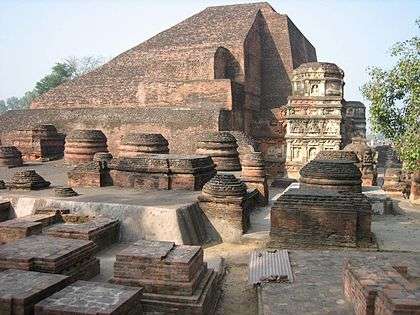Sarnath
Sarnath is a place located 10 kilometres north-east of Varanasi city near the confluence of the Ganges and the Varuna rivers in Uttar Pradesh, India. The deer park in Sarnath is where Gautama Buddha first taught the Dharma, and where the Buddhist Sangha came into existence through the enlightenment of Kondanna (Sanskrit: Kauṇḍinya).
Sarnath | |
|---|---|
Historical City | |
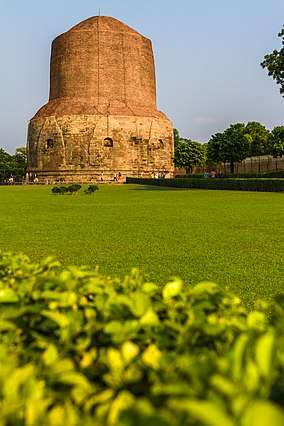 The Dhamekh Stupa, Sarnath | |
 Sarnath 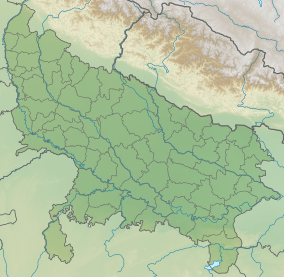 Sarnath | |
| Coordinates: 25.3811°N 83.0214°E | |
| Country | |
| State | Uttar Pradesh |
| District | Varanasi |
| Languages | |
| • Official | Hindi |
| Time zone | UTC+5:30 (IST) |
Singhpur, a village approximately one kilometer away from the site, was the birthplace of Shreyansanath, the Eleventh Tirthankara of Jainism. A temple dedicated to him is an important pilgrimage site.
Also referred to as Isipatana, this city is mentioned by the Buddha as one of the four places of pilgrimage to which his devout followers should visit.[1] It was also the site of the Buddha's Dhammacakkappavattana Sutta, which was his first teaching after attaining enlightenment, in which he taught the four noble truths and the teachings associated with it.
Origin of names
Sarnath has been variously known as Mrigadava, Migadāya, Rishipattana and Isipatana throughout its long history. Mrigadava means "deer-park". "Isipatana" is the name used in the Pali Canon, and means the place where holy men (Pali: isi, Sanskrit: rishi) landed.[2]
The legend says that when the Buddha-to-be was born, some devas came down to announce it to 500 rishis. Another explanation for the name is that Isipatana was so-called because, sages, on their way through the air (from the Himalayas), alight here or start from here on their aerial flight. Pacceka Buddhas, having spent seven days in contemplation in the Gandhamādana, bathe in the Anotatta Lake and come to the habitations of men through the air, in search of alms. They descend to earth at Isipatana.[3] Sometimes the Pacceka Buddhas come to Isipatana from Nandamūlaka-pabbhāra.[4]
Xuanzang quotes the Nigrodhamiga Jātaka (J.i.145ff) to account for the origin of the Migadāya. According to him, the Deer Park was a forest given by the king of Benares of the Jātaka, where deer might wander unmolested. The Migadāya was so-called because deer were allowed to roam about there unmolested.
Sarnath derives from the Sanskrit Sāranganātha,[5] which means "Lord of the Deer", and relates to another old Buddhist story in which the Bodhisattva is a deer and offers his life to a king instead of the doe the latter is planning to kill. The king is so moved that he creates the park as a sanctuary for deer. The park is active in modern times.
History
| Pilgrimage to |
| Buddha's Holy Sites |
|---|
 |
| The Four Main Sites |
| Four Additional Sites |
| Other Sites |
|
| Later Sites |
|
| Part of a series on |
| Buddhism |
|---|
 |
|
|
|
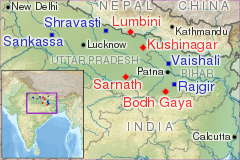
Gautama Buddha at Isipatana
Before Gautama (the Buddha-to-be) attained enlightenment, he gave up his austere penances and his friends, the Pañcavaggiya monks.[6] Seven weeks after his enlightenment under the Bodhi tree in Bodh Gaya, Buddha left Uruvela and traveled to Isipatana to rejoin them because, using his spiritual powers, he had seen that his five former companions would be able to understand Dharma quickly. While traveling to Sarnath, Gautama Buddha had no money to pay the ferryman to cross the Ganges, so he crossed it through the air. Later when King Bimbisāra heard of this, he abolished the toll for ascetics. Gautama Buddha found his five former companions and enlightened them with the teachings of the Dharma. At that time, the Sangha, the community of the enlightened ones, was founded. The sermon, Buddha gave to the five monks, was his first sermon, called the Dhammacakkappavattana Sutta. It was given on the full-moon day of Asalha Puja.[7] Buddha subsequently also spent his first rainy season at Sarnath[8] at the Mulagandhakuti. By then, the Sangha had grown to 60 in number (after Yasa and his friends had become monks), and so Buddha sent them out in all directions to travel alone and teach the Dharma. All 60 monks were Arhats.
Several other incidents connected with the Buddha, besides the preaching of the first sermon, are mentioned as having taken place in Isipatana. It was here when one day, at dawn, Yasa came to the Buddha and became an Arhat.[9] It was at Isipatana, too, that the rule was passed, prohibiting the use of sandals made of talipot leaves.[10] On another occasion when the Buddha was staying at Isipatana, having gone there from Rājagaha, he instituted rules forbidding the use of certain kinds of flesh, including human flesh.[11] Twice, while the Buddha was at Isipatana, Māra visited him but had to go away discomfited.[12]
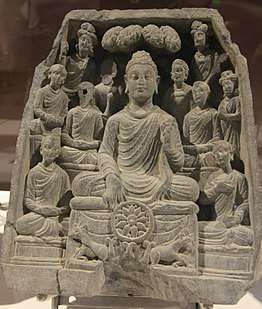
Besides the Dhammacakkappavattana Sutta mentioned above, several other suttas were preached by the Buddha while staying at Isipatana, among them
- the Saccavibhanga Sutta,
- the Pañca Sutta (S.iii.66f), most popularly known by the somewhat misleading title the Anattalakkhana Sutta
- the Rathakāra or Pacetana Sutta (A.i.110f),
- the two Pāsa Suttas (S.i.105f),
- the Samaya Sutta (A.iii.320ff),
- the Katuviya Sutta (A.i.279f.),
- a discourse on the Metteyyapañha of the Parāyana (A.iii.399f), and
- the Dhammadinna Sutta (S.v.406f), preached by the distinguished Bhikkhuni Dhammadinna to her former husband.
Some of the most eminent members of the Sangha seem to have resided at Isipatana from time to time; among recorded conversations at Isipatana are several between Sariputta and Mahakotthita,[13] and one between Mahākotthita and Citta-Hatthisariputta.[14] There is also a mention of a discourse in which several monks staying at Isipatana tried to help Channa in his difficulties.[15]
According to the Udapāna Jātaka, there was a very ancient well near Isipatana which, in the Buddha's time, was used by the monks living there.
Isipatana after the Buddha
According to the Mahavamsa, there was a large community of monks at Isipatana in the second century B.C. for, we are told that at the foundation ceremony of the Mahā Thūpa in Anurādhapura, twelve thousand monks were present from Isipatana led by the Elder Dhammasena.[16]
Xuanzang,[17] a Chinese Buddhist monk, who traveled to India in the seventh century, found fifteen hundred monks studying the Hīnayāna at the Isipatana.
In the enclosure of the Sanghārāma was a vihāra about two hundred feet high, strongly built, its roof surmounted by a golden figure of the mango. In the center of the vihāra was a life-size statue of the Buddha turning the wheel of the Law and to the south-west were the remains of a stone stupa built by King Ashoka. In front of it was a stone pillar to mark the spot where the Buddha preached his first sermon. Nearby was another stupa on the site where the Pañcavaggiyas spent their time in meditation before the Buddha's arrival, and another where five hundred Pacceka Buddhas entered Nibbāna. Close to it was another building where the future Buddha Metteyya received assurance of his becoming a Buddha.
The Divy. (389-94) mentions Ashoka as intimating to Upagupta, his desire to visit the places connected with the Buddha's activities and to erect stupas there. Thus he visited Lumbinī, Bodhimūla, Isipatana, Migadāya and Kusinagara; this is confirmed by Ashoka's lithic records, e.g. Rock Edict, viii.
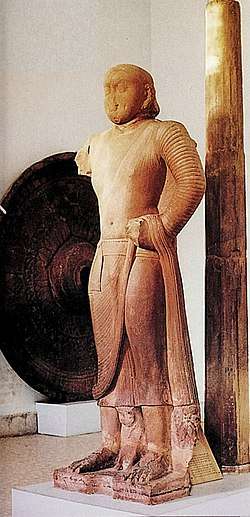
Buddhism flourished in Sarnath because of kings and wealthy merchants based in Varanasi. By the third century, Sarnath had become an important center for the arts, which reached its zenith during the Gupta period (4th to 6th centuries CE). In the 7th century by the time Xuanzang visited from China, he found 30 monasteries and 3000 monks living at Sarnath.
Sarnath became a major center of the Sammatiya school of Buddhism, one of the early Buddhist schools. However, the presence of images of Heruka and Tara indicate that Vajrayana Buddhism was (at a later time) also practiced here. Also, images of Brahminist gods as Shiva and Brahma were found at the site, and there is still a Jain temple (at Chandrapuri) located very close to the Dhamekh Stupa.
At the end of the 12th century, Sarnath was sacked by Turkish Muslims, and the site was subsequently plundered for building materials.
Discovery of Isipatana
Isipatana is identified with the modern Sarnath, six miles from Varanasi. Alexander Cunningham[18] found the Migadāya represented by a fine wood, covering an area of about half a mile, extending from the great tomb of Dhamekha on the north to the Chaukundi mound on the south.
Legendary characteristics of Isipatana
According to the Buddhist commentarial scriptures, all the Buddhas preach their first sermon at the Migadāya in Isipatana. It is one of the four avijahitatthānāni (unchanging spots), the others being the bodhi-pallanka, the spot at the gate of Sankassa, where the Buddha first touched the earth on his return from Tāvatimsa, and the site of the bed in the Gandhakuti in Jetavana[19]
In past ages, Isipatana sometimes retained its own name, as it did in the time of Phussa Buddha, Dhammadassī Buddha and Kassapa Buddha. Kassapa was born there. But more often Isipatana was known by different names (for these names see under those of the different Buddhas). Thus in the time of Vipassī Buddha, it was known as Khema-uyyāna. It is the custom for all Buddhas to go through the air to Isipatana to preach their first sermon. Gautama Buddha, however, walked all the way, eighteen leagues, because he knew that by so doing he would meet Upaka, the Ajivaka, to whom he could be of service.[20]
Jainism
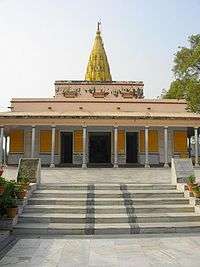
Sarnath is the birthplace of the 11th Tirthankara Shri Shreyansanatha Bhagwan. It is the place where 4 of the 5 kalyanak (auspicious life events) of Shri Shreyansanatha Bhagwan took place.
- Shri Digambar Jain Shreyansnath Mandir, Singhpuri, Sarnath
It is the place of 4 kalyanak of Shri Shreyansnath Bhagwan. A huge ashtakod stoop (octagonal pillar), 103 feet in height is still present showing its historical establishment. It is considered to be 2200 years old. The main deity of this temple is a blue colored idol of Shri Shreyansnath Bhagwan, 75 cm in height, in Padmāsana. The artistic work of this temple is unmatched.
Current features of Isipatana
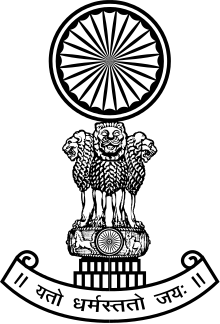
The major excavated ruins are listed below, generally in north-to-south and west-to-east order.
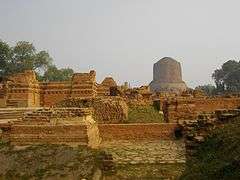
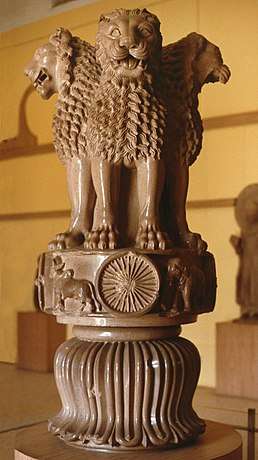
Most of the ancient buildings and structures at Sarnath were damaged or destroyed by the Turks. However, amongst the ruins can be distinguished:
- The Dharma Chakra Jina Vihar built by Kumaradevi, a wife of Gahadavala Govindachandra (c. 1114–1155 CE). An inscription mentions the building of this massive vihara. It mentions that Govindachandra had protected Varanasi from the Turushkas. This was the last construction at Sarnath before it was devastated.[21]
- The Ashoka Pillar erected here, originally surmounted by the "Lion Capital of Ashoka" (presently on display at the Sarnath Museum), was broken during Turk invasions but the base still stands at the original location. The Lion Capital now symbolizes the modern state of India. The Lion Capital served as the base of a large 32-spoke stone dharma-chakra, which was found broken into many pieces.[22] The seal of the Supreme court of India displays the Dharma Chakra as it must have originally appeared.[23]
- The ruins of the Mulagandhakuti vihara mark the place where the Buddha spent his first rainy season. This was the main temple marked by the presence of the Ashoka Pillar at the front. The famous Sarnath Buddha in dharmachakra pravartana mudra was found in the vicinity.
- The Dharmarajika Stupa is one of the few pre-Ashokan stupas remaining, although only the foundations remain. The rest of the Dharmarajika Stupa was removed to Varanasi to be used as building materials in the 18th century. At that time, relics (bone fragments) in a casket, were found in the Dharmarajika Stupa. These relics were subsequently thrown in the Ganges river, but the casket is preserved.
- The Dhamek Stupa; it is an impressive structure, 128 feet high and 93 feet in diameter.
- The Chaukhandi Stupa commemorates the spot where the Buddha met his first disciples, dating back to the fifth century or earlier and later enhanced by the addition of an octagonal tower of Islamic origin. In recent years it is undergoing restoration.
- Digambar Jain Mandir: while the current structure is from the 19th century, it occupies an ancient spot.
- The modern Mulagandhakuti Vihara is a temple built in the 1930s by the Mahabodhi Society, with beautiful wall paintings with a replica of the famous Sarnath Buddha in dharmachakra pravartana mudra.[24] Behind it is the Deer Park (where deer are still to be seen).
- The Sarnath Archeological Museum houses the famous Ashokan lion capital, which miraculously survived its 45-foot drop to the ground (from the top of the Ashokan Pillar), and became the National Emblem of India and national symbol on the Indian flag. The museum also houses a famous and refined Buddha-image of the Buddha in Dharmachakra-posture.
- There is also a Bodhi tree planted by Anagarika Dharmapala which has grown from a cutting of the Bodhi Tree at Bodh Gaya.
For Buddhists, Sarnath (or Isipatana) is one of four pilgrimage sites designated by Gautama Buddha, the other three being Kushinagar, Bodh Gaya, and Lumbini.
Modern-day pilgrimage to Sarnath
Sarnath has been developed as a place of pilgrimage, both for Buddhists from India and abroad. A number of countries in which Buddhism is a major (or the dominant) religion, such as Thailand, Japan, Tibet, Sri Lanka, and Myanmar, have established temples and monasteries in Sarnath in the style that is typical for the respective country. Thus, pilgrims and visitors have the opportunity to experience an overview of Buddhist architecture from various cultures.
| Year | International | Domestic | Total |
|---|---|---|---|
| 2013 | 362,113 | 838,566 | 1,200,679 |
| 2014 | 374,268 | 899,457 | 1,273,725 |
| 2015 | 388,102 | 924,552 | 1,312,654 |
| 2016 | 409,242 | 957,320 | 1,366,562 |
| 2017 | 430,682 | 1,024,589 | 1,455,271 |
In English literature
| Wikisource has original text related to this article: |
The plate on which Letitia Elizabeth Landon's poem Sarnat, a Bodh Monument is based shows its then run-down condition, and her words, comparing the religions of the world, pick up on the apparent weakness of Buddhism in the country of its origin at that time (1832).
Sarnath is one of the locations of Rudyard Kipling's Kim.[26] Teshoo Lama stays at the Temple of the Tirthankhars in Sarnath when not on his pilgrimages. Kim meets him there after he leaves Saint Xavier's school.
Gallery
- Dharmarajika Stupa from the pre-Ashokan Era
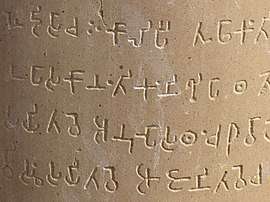 Brahmi in scriptures on the main pillar
Brahmi in scriptures on the main pillar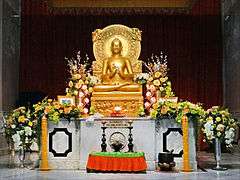 Buddha image at Sarnath
Buddha image at Sarnath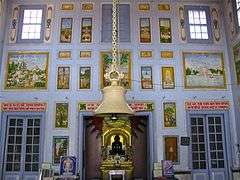 Interior of Sri Digamber Jain Shreyansnath Mandir
Interior of Sri Digamber Jain Shreyansnath Mandir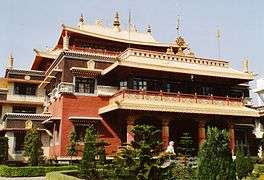 Temple of the Tibetan community in Sarnath
Temple of the Tibetan community in Sarnath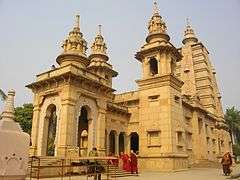 Mulagandhakuti Vihara, Sri Lankan Buddhist temple at Sarnath
Mulagandhakuti Vihara, Sri Lankan Buddhist temple at Sarnath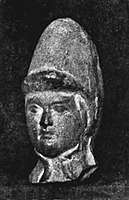 Mauryan head from Sarnath.
Mauryan head from Sarnath.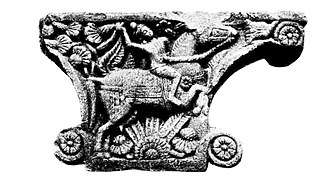 Sarnath Mauryan capital.
Sarnath Mauryan capital.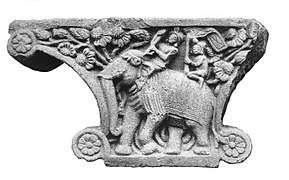 Sarnath capital with an elephant.
Sarnath capital with an elephant.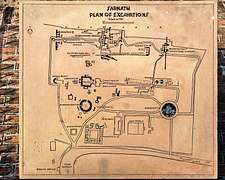 Sarnath - Plan of Excavations and constructions.
Sarnath - Plan of Excavations and constructions.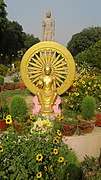 View of Lord Buddha at Thai Temple Sarnath Varanasi.
View of Lord Buddha at Thai Temple Sarnath Varanasi.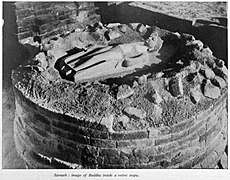 Buddha statue inside a votive stupa, Sarnath
Buddha statue inside a votive stupa, Sarnath
See also
- Adi Badri (Haryana)
- Pillars of Ashoka
- Kanaganahalli and Sannati in North Karnataka
Notes
- (D.ii.141)
- Sen, Dr. A. (2008). Buddhist remains in India. Calcutta: Maha Bodhi Book Agency. pp. 30–34. ISBN 81-87032-78-2.
- MA.i.387; AA.i.347 adds that sages also held the uposatha at Isipatana
- (MA.ii.1019; PsA.437-8)
- Schuman, Hans Wolfgang (2004). The Historical Buddha: The Times, Life, and Teachings of the Founder of Buddhism. Motilal Banarsidass. p. 67.
- J.i.68
- Vin.i.10f.; on this occasion, 80 kotis of Brahmas and innumerable gods attained the comprehension of the Truth (Mil.30); (130 kotis says Mil.350). The Lal. (528) gives details of the stages of this journey.
- BuA., p.3
- Vin.i.15f
- Vin.i.189
- Vin.i.216ff.; the rule regarding human flesh was necessary because Suppiyā made broth out of her own flesh for a sick monk.
- S.i.105f
- S.ii.112f;iii.167f;iv.162f; 384ff
- (A.iii.392f)
- S.iii.132f
- Mhv.xxix.31)
- Beal: Records of the Western World, ii.45ff
- Arch. Reports, i. p. 107
- (BuA.247; DA.ii.424).
- DA.ii.471)
- The word Jina in the name of this vihara means Buddha, not a Jain Tirthankara.
- Reverence, Resistance and Politics of Seeing the Indian National Flag, Sadan Jha, Cambridge University Press, 2016, p.117, footnote 59
- 32 Spokes Of Wisdom Our national symbol, the Ashoka pillar, has an upper chakra missing. An MP pointed it out to Nehru, but was ignored, DOLA MITRA, Outlook India, 18 JANUARY 2016
- Nakamura, Hajime (2000). Gotama Buddha. Kosei. p. 267. ISBN 4-333-01893-5.
- "ANNUAL TOURIST VISITS STATISTICS- 2013, 2014, 2015, 2016, 2017" (PDF). UP Tourism.
- Kipling, Rudyard (1901). Kim. London: MacMillan & Co. p. 266. ISBN 9781974908677.
References
- Rai Bahadur Daya Ram Sahni: Guide to the Buddhist Ruins of Sarnath with a Plan of Excavations and Five Photographic Plates. Archaeological Survey of India, Delhi 1922
- Reprint: Antiquarian Book House, Delhi/Varanasi, 1982-1983
- Satyarth Nayak: The emperor's riddles 2014
External links
| Wikiquote has quotations related to: Sarnath |
| Wikimedia Commons has media related to Sarnath. |

- Description of Sarnath by the Chinese pilgrim monk Faxian (399-414 AC)
| Edicts of Ashoka (Ruled 269–232 BCE) | |||||
| Regnal years of Ashoka |
Type of Edict (and location of the inscriptions) |
Geographical location | |||
| Year 8 | End of the Kalinga war and conversion to the "Dharma" | 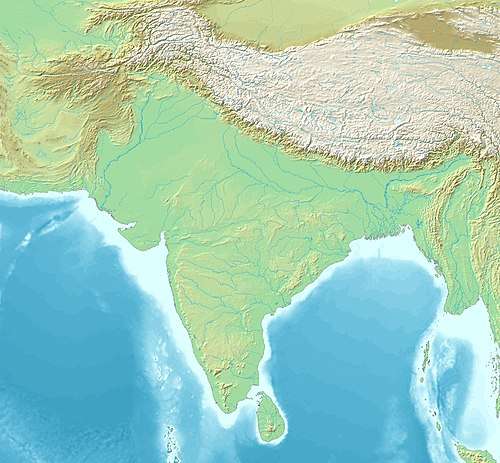 Udegolam Nittur Brahmagiri Jatinga Rajula Mandagiri Yerragudi Sasaram Barabar Kandahar (Greek and Aramaic) Kandahar Khalsi Ai Khanoum (Greek city) | |||
| Year 10[1] | Minor Rock Edicts | Related events: Visit to the Bodhi tree in Bodh Gaya Construction of the Mahabodhi Temple and Diamond throne in Bodh Gaya Predication throughout India. Dissenssions in the Sangha Third Buddhist Council In Indian language: Sohgaura inscription Erection of the Pillars of Ashoka | |||
| Kandahar Bilingual Rock Inscription (in Greek and Aramaic, Kandahar) | |||||
| Minor Rock Edicts in Aramaic: Laghman Inscription, Taxila inscription | |||||
| Year 11 and later | Minor Rock Edicts (n°1, n°2 and n°3) (Panguraria, Maski, Palkigundu and Gavimath, Bahapur/Srinivaspuri, Bairat, Ahraura, Gujarra, Sasaram, Rajula Mandagiri, Yerragudi, Udegolam, Nittur, Brahmagiri, Siddapur, Jatinga-Rameshwara) | ||||
| Year 12 and later[1] | Barabar Caves inscriptions | Major Rock Edicts | |||
| Minor Pillar Edicts | Major Rock Edicts in Greek: Edicts n°12-13 (Kandahar) Major Rock Edicts in Indian language: Edicts No.1 ~ No.14 (in Kharoshthi script: Shahbazgarhi, Mansehra Edicts (in Brahmi script: Kalsi, Girnar, Sopara, Sannati, Yerragudi, Delhi Edicts) Major Rock Edicts 1-10, 14, Separate Edicts 1&2: (Dhauli, Jaugada) | ||||
| Schism Edict, Queen's Edict (Sarnath Sanchi Allahabad) Lumbini inscription, Nigali Sagar inscription | |||||
| Year 26, 27 and later[1] |
Major Pillar Edicts | ||||
| In Indian language: Major Pillar Edicts No.1 ~ No.7 (Allahabad pillar Delhi pillar Topra Kalan Rampurva Lauria Nandangarh Lauriya-Araraj Amaravati) Derived inscriptions in Aramaic, on rock: | |||||

